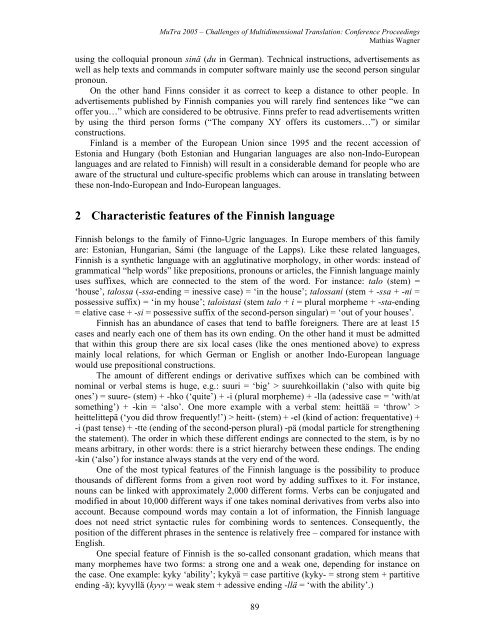Proceedings - Translation Concepts
Proceedings - Translation Concepts
Proceedings - Translation Concepts
Create successful ePaper yourself
Turn your PDF publications into a flip-book with our unique Google optimized e-Paper software.
MuTra 2005 – Challenges of Multidimensional <strong>Translation</strong>: Conference <strong>Proceedings</strong><br />
Mathias Wagner<br />
using the colloquial pronoun sinä (du in German). Technical instructions, advertisements as<br />
well as help texts and commands in computer software mainly use the second person singular<br />
pronoun.<br />
On the other hand Finns consider it as correct to keep a distance to other people. In<br />
advertisements published by Finnish companies you will rarely find sentences like “we can<br />
offer you…” which are considered to be obtrusive. Finns prefer to read advertisements written<br />
by using the third person forms (“The company XY offers its customers…”) or similar<br />
constructions.<br />
Finland is a member of the European Union since 1995 and the recent accession of<br />
Estonia and Hungary (both Estonian and Hungarian languages are also non-Indo-European<br />
languages and are related to Finnish) will result in a considerable demand for people who are<br />
aware of the structural und culture-specific problems which can arouse in translating between<br />
these non-Indo-European and Indo-European languages.<br />
2 Characteristic features of the Finnish language<br />
Finnish belongs to the family of Finno-Ugric languages. In Europe members of this family<br />
are: Estonian, Hungarian, Sámi (the language of the Lapps). Like these related languages,<br />
Finnish is a synthetic language with an agglutinative morphology, in other words: instead of<br />
grammatical “help words” like prepositions, pronouns or articles, the Finnish language mainly<br />
uses suffixes, which are connected to the stem of the word. For instance: talo (stem) =<br />
‘house’, talossa (-ssa-ending = inessive case) = ‘in the house’; talossani (stem + -ssa + -ni =<br />
possessive suffix) = ‘in my house’; taloistasi (stem talo + i = plural morpheme + -sta-ending<br />
= elative case + -si = possessive suffix of the second-person singular) = ‘out of your houses’.<br />
Finnish has an abundance of cases that tend to baffle foreigners. There are at least 15<br />
cases and nearly each one of them has its own ending. On the other hand it must be admitted<br />
that within this group there are six local cases (like the ones mentioned above) to express<br />
mainly local relations, for which German or English or another Indo-European language<br />
would use prepositional constructions.<br />
The amount of different endings or derivative suffixes which can be combined with<br />
nominal or verbal stems is huge, e.g.: suuri = ‘big’ > suurehkoillakin (‘also with quite big<br />
ones’) = suure- (stem) + -hko (‘quite’) + -i (plural morpheme) + -lla (adessive case = ‘with/at<br />
something’) + -kin = ‘also’. One more example with a verbal stem: heittää = ‘throw’ ><br />
heittelittepä (‘you did throw frequently!’) > heitt- (stem) + -el (kind of action: frequentative) +<br />
-i (past tense) + -tte (ending of the second-person plural) -pä (modal particle for strengthening<br />
the statement). The order in which these different endings are connected to the stem, is by no<br />
means arbitrary, in other words: there is a strict hierarchy between these endings. The ending<br />
-kin (‘also’) for instance always stands at the very end of the word.<br />
One of the most typical features of the Finnish language is the possibility to produce<br />
thousands of different forms from a given root word by adding suffixes to it. For instance,<br />
nouns can be linked with approximately 2,000 different forms. Verbs can be conjugated and<br />
modified in about 10,000 different ways if one takes nominal derivatives from verbs also into<br />
account. Because compound words may contain a lot of information, the Finnish language<br />
does not need strict syntactic rules for combining words to sentences. Consequently, the<br />
position of the different phrases in the sentence is relatively free – compared for instance with<br />
English.<br />
One special feature of Finnish is the so-called consonant gradation, which means that<br />
many morphemes have two forms: a strong one and a weak one, depending for instance on<br />
the case. One example: kyky ‘ability’; kykyä = case partitive (kyky- = strong stem + partitive<br />
ending -ä); kyvyllä (kyvy = weak stem + adessive ending -llä = ‘with the ability’.)<br />
89
















